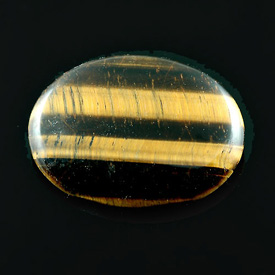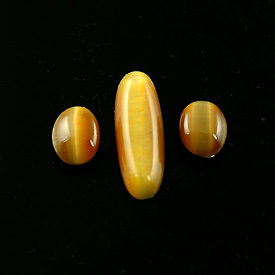| Tiger eye is an amphibole (fibrous) partially replaced or cemented with silica. Before becoming tiger eye the mineral was asbestos. Most of the tiger eye colors are from iron. It is often found with hematite or red (iron containing) jasper. The original mineral, "riebeckite" is known as blue asbestos. The fibrous variety of riebeckite is called "crocidolite" (hence tiger eyes second name.)
Riebeckite is unusual in that it has two iron atoms in its formula with different oxidation states. The yellow coloration is likely due to the formation of limonite, a yellow iron oxide.
The samples here are the most common yellow (or golden) tiger eye. The top stone is a commercial cut stone, The next set of three are also commercially cut and go under he name "honey" tiger eye due to their lighter color and very fine silk.
Some of the high purity material. lighter colored material that shows strong "cats eye" effect may be a bleached tiger eye using a process developed in the gem cutting city of Idar-Oberstein, Germany.
Tiger eye displays "chatoyancy", kind of an inner mobile light glow that moves around between the fibers. It is caused by light reflecting between the parallel fibers.
The smaples are likely from Australia or Africa, the two main sources for tiger eye.
|



